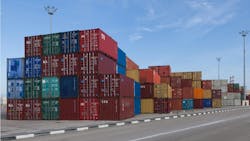Can Automated Terminal Solutions Solve Your Container Woes?
What You’ll Learn:
- How supply chain professionals benefit from port automation.
- What types of automated technologies ports may deploy.
Today’s ports are bustling centers of activity and essential for the smooth operation of international trade. Recognizing how even minor delays can have far-reaching effects, many port managers are interested in options such as container terminal automation. The associated technologies can help users cope with labor shortages, increased goods volumes and other challenges. How can—and should—decision-makers apply port automation to meet their present and future needs?
Evaluating the Potential Benefits With Hybrid Test Scenarios
Container terminal automation looks different depending on individual layouts, container volumes and the budgets and goals of those considering it. Executives overseeing the first fully automated container terminal in Korea wanted to investigate opportunities for using automated guided vehicles at their facility. The infrastructure already included oceanside container gantry cranes and landside cranes in the yard. Those involved intended to fill an automated horizontal transportation gap with the AGVs but wanted to simulate the potential effects first.
One executive clarified that this approach to port automation included equipping the AGVs with future data from a terminal operating system under development and using digital twins to study the outcomes. The strategy allowed evaluating the AGVs’ performance under realistic conditions before commissioning them for the task. It also shortened the validation process, giving executives the necessary confidence to feel upbeat about the port’s future and how it utilizes technology.
Digital twins are ideal for helping users visualize the impacts of various factors that may affect port traffic, employee workloads and how well future technologies work alongside those already implemented. A digital twin’s output for AGVs could also assist leaders in making important decisions, such as how many to deploy during a trial and which routes the vehicles should take for maximum efficiency.
Other fascinating applications have occurred outside of the world’s ports, too. In one case, a bike-sharing program’s workers used a digital twin to optimize availability and address the challenges caused by customers returning their bicycles to different locations from where they were obtained. Participants anticipated a 30% efficiency boost with this method and believed it would improve bike maintenance.
Using technology to facilitate smooth movement—whether of bikes or shipping containers—avoids wasted time and energy.
Supplementing the Labor Force With Advanced Technologies
Persistent workforce shortages have become a driving force in encouraging executives to explore automated container terminal solutions. Seasonal demand surges, strikes and widespread resignations can all significantly impact port operations. Delays can arise even once containers reach terminals because not enough people are available to unload them.
However, some port officials tackle the issue with automation that supports workers’ activities. That strategy results in more getting done than if humans assume the responsibilities alone. In one example, the warehousing and logistics arm of a French container ship company added robots to assist with transloading activities near California’s Long Beach and Los Angeles Ports, which collectively represent the U.S.’s largest import gateways.
The purpose-built robot can unload non-palletized shipping containers, grabbing boxes as heavy as 50 lb with its suction cup-equipped arm and transferring them to conveyors. Due to its 16-hour battery life, the machine can run for the equivalent of two shifts before requiring recharging.
Some leaders have also explored options that support container terminal automation, lightening intensive workloads for port staff. Such strategies could reduce turnover rates by making daily tasks less strenuous for those assigned to them. Although the workers at one Italian port still perform most logistics and cargo-handling duties manually, they have received robotic exoskeletons to improve workflows.
A trial of the specialized suits involved participants having muscle activity measurements performed as they worked. The employees also completed questionnaires detailing their perceived muscular fatigue. The results indicated that the technology could reduce worker effort by up to 30%, causing a safer and more comfortable experience.
Using Container Terminal Automation to Reduce Accidents
Huge ships, large batches of heavy containers and perpetually busy areas can create risky conditions that require workers to always remain aware of their surroundings and follow best practices for their tasks. Besides having staff members undergo regular training, managers should have issue-reporting systems that make it easy for people to report dangers they notice while working.
Making ports safer is central to many leaders’ decisions to implement automation. Manual tasks are often more error-prone than those handled by machines. Tired or distracted people are more likely to make mistakes that lead to accidents or fatalities. Following new standards is also essential for risk reduction in ports and other industrial environments. Experts refresh such guidance after extensive consultations with relevant parties.
A standard for overhead and gantry cranes received a 2023 update to improve relevance. One detail concerns lift weights greater than 125% of the crane’s rated load. In such cases, the manufacturer or another appropriately qualified party must inspect the equipment to verify that it can safely handle the task. Thanks to those essential checks, it becomes more likely that people will spot abnormalities that increase risks.
Leaders should also determine whether automated solutions could bring additional threat-reduction benefits. Accident prevention successes have ripple effects that benefit the company and everyone impacted by it. For example, injury rates should decrease, and people will feel more loyal when working at ports with above-average safety.
In one case, a European agency and shipping company collaborated on an automated berthing solution that works via satellite data. Docking is a hazardous activity with high accident rates. This project’s earliest stages involved partially automated functionality that assists the ship’s master. However, participants hope to eventually achieve full automation.
Minimizing Wait Times With Port Automation
Besides automated container terminal technologies that facilitate the efficient movement of the world’s goods, strategically applied solutions can shorten or eliminate delays for people passing through ports. Tens of millions of cruise passengers depart from or arrive at them during their journeys, and these locations are essential for all water-based border crossings. Plus, people-related backups could adversely affect the port’s container-related activities, much to the dismay of the world’s supply chain professionals who hope for the smoothest possible goods transfers.
Port officials deemed an Indonesian port an ideal candidate for automated options due to its major role in international transport and trade. Each year, approximately 500,000 people pass through its five seaports, often while traveling to or from Malaysia and Singapore. However, an internal investigation identified manual document verification processes as significant pain points disrupting the facility’s operations.
That being said, a recently deployed automated system uses biometrics to determine whether the documents match the person attempting to travel through the port. Multispectral imaging technology and artificial intelligence also keep the solution performing reliably, even in low-light conditions. The checks now take place in seconds, keeping port operations productive and reducing backups.
Such successes elsewhere could help supply chain professionals identify the most dependable transit routes versus those more likely to experience backups, providing them with information to help solve many of their container woes.
Making Busy Ports More Streamlined
Whether port managers choose container terminal automation or robotic exoskeletons to assist employees, advanced technologies can relieve backups and boost output. These results help the world’s seaports operate efficiently and effectively.
About the Author

Emily Newton
Emily Newton has eight years of creating logistics and supply chain articles under her belt. She loves helping people stay informed about industry trends. Her work in Supply Chain Connect, Global Trade Magazine and Parcel, showcases her ability to identify newsworthy stories. When Emily isn't writing, she enjoys building lego sets with her husband.






